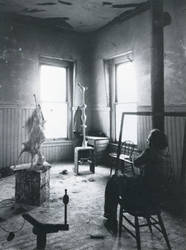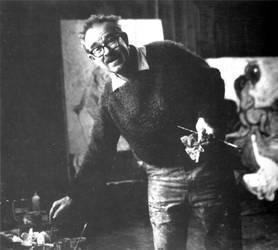
© 2021 The Estate of Hassel Smith
All Rights Reserved.

© 2021 The Estate of Hassel Smith
All Rights Reserved.



1915
Hassel Smith was born to Hassel and Helen Adams Smith, Sr. on April 24 in Sturgis, Michigan, a small factory town between Detroit and Chicago. The family adopted a boy, Lewis, of the same age. Helen contracted tuberculosis.
1918-23
For the sake of his mother's health, moved to Denver, then Los Angeles, San Mateo, and Mill Valley, California. Moved back to Sturgis, where his father worked for the Kirsch-Rod Company. "I have done a lot of traveling back and forth across the United States by every known conveyance except horse... I think it is a significant part, a pattern of my life that I have constantly moved, from one place to another."
1929-32
After one year of high school in Michigan, he returned to San Mateo, California, graduating from San Mateo Union High School.
1932-35
"I went east again to attend Northwestern University in Evanston, Illinois, a suburb of Chicago. My intention was to become a chemist. I did well enough in this subject, brilliantly, in fact. However, German, required in those days for a science career, defeated me. I changed over to art history and English literature, a wise choice as it turned out. Thus began my actual art career, my love affair with painting. The enlightened (for those days) course description for art history at Northwestern included "practice" so we did some painting, sculpture not being on offer."
While at Northwestern he was exposed to painting at the World's Fair in Chicago and to the Diaghilev Company of the Ballet Russe de Monte Carlo, directed by Massine.
"I had simply not dreamed that such a thing was possible. It had an enormous influence on me ... within a very short time I encountered many of the recognized masterpieces of modern art, not only in painting and sculpture, but also in the ballet. I had no hesitation whatsoever in liking them and committing myself to them." "Lautrec, Van Gogh, Gauguin, Seurat, Monet, Cezanne (all wonderfully represented in the Birch-Bartlett collection), Miró, Brancusi, Leger, Duchamp, Matisse, Picasso, Mondrian, Dalí ... I was wowed by them all and have been a confirmed modernist ever since."
Smith's enduring commitment to jazz and other forms of innovative musical expression receives its first major impulse from regular visits to the bars and dancehalls of mid-thirties Chicago.
1936
Received Bachelor of Science degree cum laude from Northwestern University with a double major: art history and English literature. Intended to go to Princeton to do graduate work in art history, but returned to the Bay Area and enrolled at the California School of Fine Arts (now San Francisco Art Institute). Was permitted to join Maurice Sterne's elite painting and drawing class in which he remained for nearly two years. "Sterne's approach to drawing from the model (nature) was a revelation. I have no hesitation in saying that to whatever extent my intellect has been engaged in the joys and mysteries of transferring visual observations in three dimensions into meaningful two-dimensional marks and shapes, I owe to Sterne."
1937
Left the CSFA with Jack Wilkinson. In San Francisco, lived in the San Remo Hotel at Chestnut and Mason (still there) then moved into a studio in the Montgomery Block previously occupied by Maynard Dixon. They painted outdoors. "We also attempted to arrange figure compositions in the manner of Poussin." At night he drew in the WPA life classes and frequented the Black Cat Café, where he met Henri Lenoir, Hilaire Hiler, Matthew Barnes, and others.
1939
Employed by the California State Relief Administration, supervised a single-men's caseload on Skid Row in San Francisco. Lived with his brother Lewis in a boarding house in the Haight-Ashbury district. "It was a very good experience ... shattering." "I had a proper little studio on Steiner Street and in off-hours and weekends got on with the painting."
1941
Received an Abraham Rosenberg Fellowship for independent study and moved to Angels Camp in the Mother Lode of the Sierra foothills. "With Richard Hackett, I painted out of doors very much in the spirit of the great peasant painters, Van Gogh, Cezanne, Pissaro, and in a countryside very like in climate and appearance to that of the South of France."
1942-44
Went to work for the Farm Security Administration of the US Department of Agriculture. Sent to Arvin, California; issued food stamps. Met and married his wife June Meyers, a social worker in the migratory labor program. "This is an episode in my life that requires its own book-and I'll not get into it here-but it had a profound influence on me. Suffice it to say that in off-times and while living in the Arvin Farm Worker Community I managed to do a lot of drawings in the cotton and tomato fields." "It seems to me that the drawings that I began to make in the valley of field workers and so on, are among the first things which I consider to have really quite significant quality."
1944
The FSA was phased out by Congress, and he was transferred to the Forest Service. Spent the remainder of the war as a timber scaler on the McKenzie River in Oregon.
1945
The war over, he and his wife returned to the Bay Area where he taught at CSFA as an assistant to Ray Bertrand in the lithography workshop.
1945-51
With Robert McChesney and Edward Corbett, he was founding member of the Artist's Guild, first postwar artist-run gallery in North Beach. Douglas MacAgy (wife Jermayne was the assistant director at the Palace of the Legion of Honor) became the new director of the California School of Fine Arts (CSFA) and re-organized the staff and program. Hassel Smith joined a distinguished group that included Clyfford Still, David Park, Elmer Bischoff, Jean Varda, Clay Spohn, Robert Howard, Walter Landor, Dorr Bothwell, Edward Corbett, Claire Falkenstein, Ansel Adams, Richard Diebenkorn, and others. Summer visitors included Mark Rothko, Ad Reinhardt, Stanley William Hayter, and others. "The point that I would like to make most especially is that for many of us who were on the staff, the experience was as much, or even more, a learning experience than a teaching one." Students during this period included amongst others Frank Lobdell, Deborah Remington, James Kelly, Sonia Gechtoff, Adelie Landis (Bischoff), Lilly Fenichel, Roy De Forest, Ernest Briggs, John Hultberg, Julius Wasserstein, Jack Jefferson, and Madeleine Dimond (Martin).
1947
Saw Still's exhibition at the California Palace of the Legion of Honor. "It had a tremendous effect on me and various other people as well ... Rothko and Clyfford Still were at the time great friends and they had a lot of influence on the younger people, including myself."
First artist in upper story at 9 Mission Street, a historical landmark and legendary studio building for over twenty years. Artists who worked there included Ruth Bernhard, Julius Hatofsky, Lobdell, Jefferson, Briggs, Charles Safford, Manuel Neri, Joan Brown, and Julius Wasserstein. First museum solo exhibition at the California Palace of the Legion of Honor, San Francisco, California.
Birth of son Joseph. Family moved to Eugene, Oregon, where Smith joined former studio mate and painting companion Jack Wilkinson on the staff at the university.
1948
Returned to the Bay Area and went back to work at CSFA. The Smith family lived at Point Richmond with Robert and Mary Fuller McChesney, Ed Corbett, and Weldon Kees. Group exhibition Elmer Bischoff, David Park, Hassell (sic) Smith, San Francisco Museum of Art (now Modern Art).
1952
Part of a group forced out of CSFA by the new Director, Ernst Mundt. Taught Arts and Crafts at Presidio Hill School, children's art classes at Mission Community Center, weekly seminars at his Potrero Hill district home, and painted in his 9 Mission Street studio. Included with his Mission Street students in Jess and Robert Duncan's inaugural exhibition for King Ubu gallery, Large-scale Drawings.
1953
Acquired apple orchard in Sebastopol, Sonoma County; built studio, worked orchard, continued to paint. Keen collector of Native American artifacts and old bottles. Also active as an amateur geologist.
1955
"Merry-Go-Round" or Action show at Santa Monica Pier jointly organized by The Six Gallery and Walter Hopps' Syndell Gallery in Los Angeles. Bern Porter publishes Constructions, portfolio of photographs by Harry Bowden of Smith's assemblages.
1958
First exhibition at the Ferus Gallery founded by Walter Hopps and Edward Kienholz in Los Angeles, meeting Peter Voulkos, John Altoon, Billy Al Bengston, Edward Moses, and others. Hopps wrote of Smith, "I'm sure you know a good deal about Hassel Smith, painter, man, legend as a renegade, teacher and leading free spirit of art here in the Far West. Hassel has caused some furious storms and is in my opinion among the four finest artists to come out of the West, Diebenkorn, Lobdell, Corbett, Smith."
Began exhibiting at Jim Newman's Dilexi Gallery in San Francisco.
June Meyers Smith died.
Began to make his living from painting sales.
1959
Smith married Donna Raffety Harrington. She had two sons, Mark and Stephan. Birth of son Bruce in 1960. "Soon we had Bruce, so we made up a family and have been together ever since."
Exhibition at New Arts, Houston, curated by director Kathryn Swenson.
"Charles Gimpel saw my work in Houston and started to show the paintings in London, and he arranged for my paintings to be shown in New York (1961) with André Emmerich."
1962
Went to England to live for one year in Mousehole, a Cornish fishing village.
Avid participant on family excursions to the countryside, stately homes, cathedrals, and castles.
1963-65
Returned to California as a lecturer in the art department at the University of California at Berkeley.
1965-66
Moved to Los Angeles as an associate professor in the art department at the University of California at Los Angeles.
1966
Offered a position at the Royal West of England College of Art in Bristol, England, where he was a senior lecturer until 1978.
1967
Received an award from the National Endowment for the Arts for "Distinguished Service to American Art."
1973-75
Visiting professor in the art department at the University of California at Davis.
1977-80
Instructor, San Francisco Art Institute.
1978-80
Principal lecturer, faculty of art, Bristol Polytechnic, England, and the Cardiff College of Art, Wales.
1980
Moves from Bristol to Rode in Somerset. A life-long philatelist, he sells his stamp collection to finance studio renovations to the outbuildings of an eighteenth-century rectory.
1981
Award for "Outstanding Achievement in Painting" from the Art Commission of the City and County of San Francisco.
Guest artist, San Francisco Art Institute. "I feel that I can live in one place and yet not abandon all my contacts in the other."
1986-87
Produces lithographs and monotypes at Magnolia Press, Oakland, exhibited at the Smith Andersen Gallery.
1988
Awarded the Cunningham Endowed Chair, College of Notre Dame. "To put it very briefly, it means as far as I'm concerned I'm bringing the painting into much closer relation with music, the dance with verse, and the various discursive art forms in which rhythmic sequences play a role."
1991
Awarded an honorary doctorate by the San Francisco Art Institute.
1980-97
A prolific period of painting at the studio in Rode, until Smith was forced to stop work due to ill health in December 1997.
2007
Hassel Smith died on January 2 at Sutton Veny Nursing Home, near Warminster in Wiltshire.
2008
March 3: Celebration of the life and work of Hassel Smith at San Francisco Art Institute
Quotations taken from: Oral history interview with Hassel Smith [by Paul J. Karlstrom], 1978 Sept. 5, Archives of American Art, Smithsonian Institution; Allan Temko, Hassel Smith: Painting, 1954-1975, exh. cat. San Francisco Museum of Modern Art (1975); Letter to Mrs. Kathryn Swenson from Walter Hopps, October 20, 1958, in New Arts [gallery] records, 1952-1977, Archives of American Art, Smithsonian Institution.